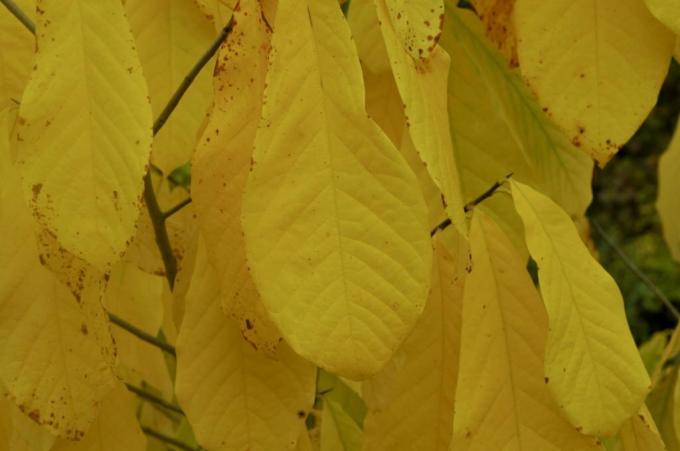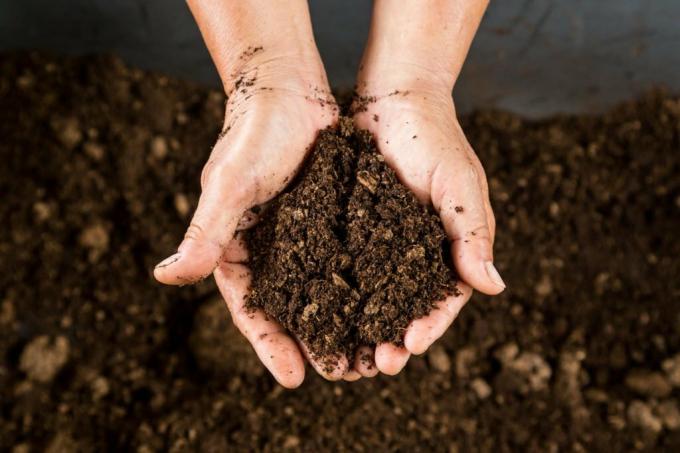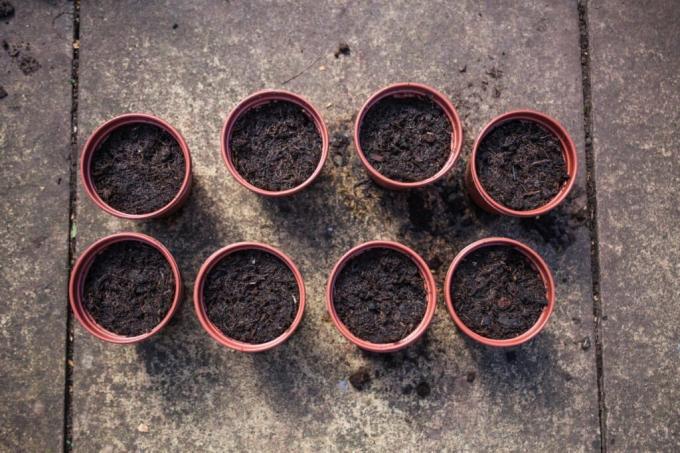The North American pawpaw is becoming increasingly popular. Here you can find out everything about the exotic Indian banana - from buying to planting to caring for it.

Apples (Malus) or Pears (Pyrus) almost everyone has their own garden. Are you in the mood for a new, still largely unknown and exotic plant? Then the Indian banana (Asimina triloba) maybe just right for you. The fruit of the Indian banana actually looks a lot more like a mango or papaya. In our article you can find out where the Indian banana got its name from, how it is best planted and cared for and how you can best harvest and store this exotic fruit.
contents
- Indian bananas (pawpaw): origin and properties
- Buy Indian banana
-
Planting Indian bananas
- The perfect location for the pawpaw
- Procedure for planting the Indian banana
- Propagate Indian bananas
-
Maintaining Indian bananas
- Pour Indian banana
- Cut Indian banana
- Fertilize Indian banana
- Wintering Indian bananas
- Harvest and store Indian bananas
- Taste and use of the Indian banana
The Indian banana is a fruit of the Annonaceae family and has many names: Derived from its Latin name Asimina triloba it is also called Dreilappiger Papau in German. Other common names for the Indian banana are Michigan Banana, Poor Men`s Banana (in German "poor man's banana"), Papau or Pawpaw. It owes the latter name to its similarity to papaya. Both fruits look very similar, but the Indian banana is significantly smaller and lighter than a papaya. The name Indian banana comes first of all from the North American origin of the plant and from the fact that the flesh of the Indian banana is yellow and soft like a real one banana (Musa).
The taste of the pawpaw can most likely be described as a mix of mango, pineapple, apricot and banana with a hint of it of vanilla, the flesh of which is similarly soft and creamy to that of conventional ones Bananas. If you want to enjoy this special taste, you can grow and harvest the Indian banana yourself in your own garden. Another reason to give the Pawpaw a place in the garden is its high value as an ornamental wood: especially in the In autumn the leaves of the plant turn beautiful yellow and leave your garden in the most beautiful colors shine.
Indian bananas (pawpaw): origin and properties
The Indian banana has its real home in North America. It is widespread in both the southeastern United States and southern Canada. Originally, the Indian banana was a riparian forest plant that felt most comfortable in swampy areas and at the edges of the forest in the shade of larger trees. The Native Americans already valued this particular fruit. Today the Indian banana is also grown in Europe, especially in Italy and in German-speaking countries. However, the commercial cultivation of pawpaws is extremely low, so you will have a hard time spotting a pawpaw fruit in the supermarket. It is therefore all the more attractive to grow the special plant yourself and harvest your own fruits.

The Indian banana is a deciduous shrub and can grow three to five meters in height. The plant forms a closed crown that can be up to two and a half meters in diameter. It grows relatively slowly at around 30 centimeters per year. Its elongated leaves, up to 20 centimeters in size, are impressive. From May the Indian banana begins to bloom with purple bell flowers. From this the fruits develop, which ripen from August to the beginning of October. In autumn the leaves turn golden.
Buy Indian banana
When purchasing your Indian banana, the size of the plant and the variety should be of the utmost importance. The size of the plant determines whether you can plant your Indian banana outdoors right away, or whether you continue to cultivate it in a pot for a year or two. The price is particularly important here, because larger Indian bananas cost many times more than smaller ones. On the other hand, seedlings (still small plants) usually bear smaller fruits, have a fluctuating yield and are often not recommended in terms of taste.
Another important decision criterion when buying something should be the variety. Because only the two varieties 'Prima' and 'Sunflower' are self-pollinating. All other varieties are not self-pollinating and therefore require a cross-pollinator.
A detailed guide to the Purchase of Indian bananas You will find here.
Planting Indian bananas
The Indian banana is one of the few exotic plants that are hardy and can therefore be cultivated outside in our garden all year round. The choice of location and the right approach to planting are crucial here.

The perfect location for the pawpaw
If the Pawpaw originally grows on the edge of the forest, one could assume that it prefers a shady location. But that's only half true. In its young development, i.e. in the first four years, the young Indian banana should by no means be in the blazing sun. A partially shaded location is ideal here. From the fourth year the pawpaw begins to bear fruit. Then she would like to stand in as sunny a location as possible. If the fruits are kissed sufficiently by the sun, they can develop their aroma particularly well and become nice and sweet.
You should also differentiate between young plants and older plants when it comes to frost resistance: Young plants should be protected from severe frost for the first four years. You can use a fleece to cover it, for example. Adult plants, on the other hand, defy frost down to -30 ° C and no longer need protection in winter. The pawpaw has low demands on the soil: it should only be loose and nutritious. The peat-free and sustainable Plantura organic universal soil is therefore ideal for your pawpaw. In the case of very sandy soils, you can enrich the earth with compost or other organic material in order to improve the soil structure and the supply of nutrients.
If you only have nutrient-poor material available to enrich the soil, such as straw, we recommend an additional enrichment with organic slow-release fertilizer. Our Plantura organic universal fertilizer with organic long-term effects not only improves the soil structure in the long term, but also releases the nutrients gently and over a longer period of time to the Indian banana. A pH value between 5.5 to 7 is optimal for the Pawpaw. The soil should be sufficiently moist and never dry out completely. However, waterlogging must not occur under any circumstances, as this can lead to root rot.
The location requirements of the Indian banana at a glance:
- In the first four years in a partially shaded location and protect against heavy frost in winter
- From the fourth year: Sunny location
- Frost tolerance down to -30 ° C
- Nutrient-rich, moist, loose soil
- pH value: 5.5 to 7
- Avoid waterlogging at all costs

Procedure for planting the Indian banana
The best time to plant the Indian banana is from late September to October or in spring in March. It is important that the plants have formed a good root system when they were planted out. When buying plants that are still small in 3-liter containers, it makes sense to cultivate them in a pot in a partially shaded location for two more years. If the plant has grown sufficiently over the next few years and the root ball has developed well, you can put the plant outdoors.
If you buy a larger plant in a 6 liter container, it can be planted outdoors immediately. Once the ideal location has been found, the planting hole is prepared. Remove weeds, stones, or roots and add compost or other organic matter to the soil. Alternatively, you can also use organic long-term fertilizers for this. The planting hole should be at least twice the diameter and twice the depth of the plant's root ball. The plant should be as deep in the planting hole as it was in the container or pot before. Then fill the planting hole with the enriched soil and water the plant well. The planting distance to the next neighboring plant should be at least three meters.
An overview of the Indian banana plants:
- Choose ideal location
- Enrich the soil with compost or organic slow release fertilizer
- Dig a planting hole twice the diameter and twice the depth of the root ball
- Put the Indian banana as deep as it is in the pot or Container was
- Water well
- Plant distance to neighboring plants at least 3 m
Tip: Since the Indian banana grows very slowly, you should keep a circle around the stem of the plant within a radius of 50 centimeters free of weeds and grass. So the competition for water and nutrients is not too high for the pawpaw. A layer of mulch can also be applied here, which suppresses weeds and also ensures less evaporation. You can use leaves or grass clippings as mulch material, for example.

The Indian banana can also be grown in a pot on the balcony or terrace. Since the pawpaw is a taproot, the planter must be sufficiently large and deep. The planter should therefore be able to hold at least 40 liters. Also, make sure that the pot has a drainage hole and put a drainage layer on it. When planting in pots, make sure that the substrate is sufficiently loose, rich in nutrients. In summer, the plant can be in partial shade for the first few years, and later in the sun. The Indian banana should spend the winter in a cool place so that it can hibernate sufficiently. Heated rooms are not suitable for this. Indian bananas cultivated in pots can grow up to three meters high.
Planting Indian banana in a pot:
- Sufficiently large planter with drain and drainage layer
- Loose, nutrient-rich substrate
- In the first few years partially shaded, later sunny location
- Winter in a cool place
Propagate Indian bananas
Propagating Indian bananas yourself is not that easy, but not impossible. There are two methods for this: Propagation by seeds or by grafting. When propagating the pawpaw by seeds, you can either take seeds from your own fruits or buy seeds accordingly. In the next step, the seeds must be stratified, i.e. made germinable. In the case of the Indian banana, this is done by exposure to the cold. To do this, plant the individual seeds in seed pots and then put them outside over the winter until the next autumn. The seeds need the cold stimulus to germinate. In the case of the Indian banana, it takes about nine months for the seeds to germinate and for a small above-ground plant to appear in the pot. During this time you should always keep the substrate sufficiently moist. The plant survives the first winter in the house or in the greenhouse. In the second year it can then be repotted in a larger pot and in the following years, as soon as it is sufficiently large and has formed enough root mass, put outside.

Procedure for propagation via seeds:
- Obtain or buy seeds from your own fruits
- Stratify seeds (cold stimulus)
- Germination takes 9 months
- Always keep the substrate sufficiently moist
- The first winter in the greenhouse or house
- Repot in the second year
The second way to propagate Indian bananas yourself is through processing. When refining, a noble rice from the Indian banana is grafted onto a seedling base. As a seedling base, seedlings or runners of the pawpaw itself can be used. No other documents are known so far to refine Indian bananas. The most commonly used refinement method for Indian bananas is chipping. For this purpose, a piece of rice that is only three to four centimeters long is removed, the so-called chip. This is then placed on a prefabricated recess in the base. It is important to work very cleanly here. Chipping can be carried out between March and October - the only requirement is that both a noble rice and the base are available at the same time.
Maintaining Indian bananas
The Indian banana also needs to be properly cared for. This of course includes proper watering, cutting and fertilizing. A specialty of the care of Indian bananas is the pollination. Although some varieties of Indian banana are self-pollinating, the fruit yield is significantly higher if at least two plants of different varieties are planted. Indian bananas are pollinated by insects. We do not have many of the typical pollinators that the Indian banana relies on in North America. Unfortunately, bees disdain the flowers of the Indian banana, with us they only pollinate a few types of flies. You can therefore become a "bee" yourself and pollinate your Indian bananas. To do this, take a brush and carefully remove pollen of one genotype from the stamens of one plant. You now apply these to the stigmas of the plant of the other variety with the other genotype.
Pour Indian banana
Originating from the riparian forests of North America, the Indian banana does not tolerate drought at all. Therefore, the soil should also be kept moist by watering it regularly in the field. If the Pawpaw is grown in a pot, you should always keep the substrate moist. However, no water should collect in the planter - then you have clearly poured too much. It is better to water twice less on hot days than too much all at once.

Cut Indian banana
In the first three years, it is not necessary to cut the slowly growing Indian banana. Only when the plant begins to bear fruit can it be cut from time to time. Branches that are too steep can be removed, as can dead or diseased wood. If your potted plant is getting too big for you, you can cut the main shoot here to a height of three meters. Otherwise, it is advisable to remove leaves that cast shadows on the ripening fruit. Because enough sun is absolutely necessary for the delicious fruits of the Indian banana to ripen well.
Fertilize Indian banana
Fertilizing the Indian banana with organic slow-release fertilizer is recommended in spring. For example, there are compost, Horn shavings or an organic fertilizer with long-term effects. Our Plantura Organic universal fertilizer with organic long-term effects optimally covers the nutritional requirements of the Indian banana and is also more environmentally friendly than mineral fertilizers. During the growing season, fertilization with a high concentration of potassium is also important. This promotes fruit formation. It can be applied as foliar fertilization, for example.
Wintering Indian bananas
A tropical fruit plant that will survive our freezing winters? That is impossible. Yes - the Indian banana can do just that. When fully grown, it defies temperatures as low as -30 ° C. So she doesn't mind snow and cold. On the contrary, it even needs the cold spells for its well-deserved hibernation. Potted plants should therefore also spend the winter in a cool place.
Young Indian bananas, however, are less cold-tolerant. These should be protected from excessive frost. To avoid frost cracks on the trunk, you can paint the trunk white in good time. Alternatively, you can protect the trunk with a fleece. In this way, young pawpaw plants also survive the winter well.

Harvest and store Indian bananas
Seedlings take about seven to ten years to first bear fruit. Grafted plants usually bear fruit for the first time in the third to fourth year after being planted in the garden. These ripen from the end of August. However, it can take until November until all the fruits are ripe. That depends a lot on the variety. A sign that the fruit is ripe is that the skin changes color. The green, unripe fruits slowly turn light green or even slightly yellowish when they get ripe. Another sign is that the shell is easy to indent. In addition, the ripening fruits begin to smell. When harvesting, you should be careful not to damage the delicate fruits. Indian bananas get bruises very easily. You should therefore only handle it very carefully and then turn it slightly. This is how the fruit loosens. The fruits of the pawpaw are very perishable and can only be stored for three days at room temperature. On the other hand, fruits that have not yet been harvested ripen very well. Half-ripe pawpaws can be stored in the refrigerator for up to four weeks. Alternatively, ripe fruits can also be stored in the freezer.

Taste and use of the Indian banana
The fruits of the Indian banana are reminiscent of a still green mango or a small unripe papaya. If you cut the fruit lengthways, you will see yellow pulp, interspersed with brown-black, thick kernels. The pulp tastes like a whole tropical fruit cocktail: It is reminiscent of a mixture of banana, pineapple, mango and passion fruit with a hint of vanilla. The flesh is very soft and can be scraped off with a spoon or spooned straight out of the fruit. You can simply enjoy pawpaws on their own, or use them for quark dishes, smoothies or fruit tarts. A delicious ice cream can also be made from the Indian bananas.
The fruits are rich in unsaturated fatty acids and also contain many vitamins and minerals such as iron, calcium and vitamins A and C. The Indian banana is a real super fruit that, as long as it is grown by us, also has a great ecological balance.
